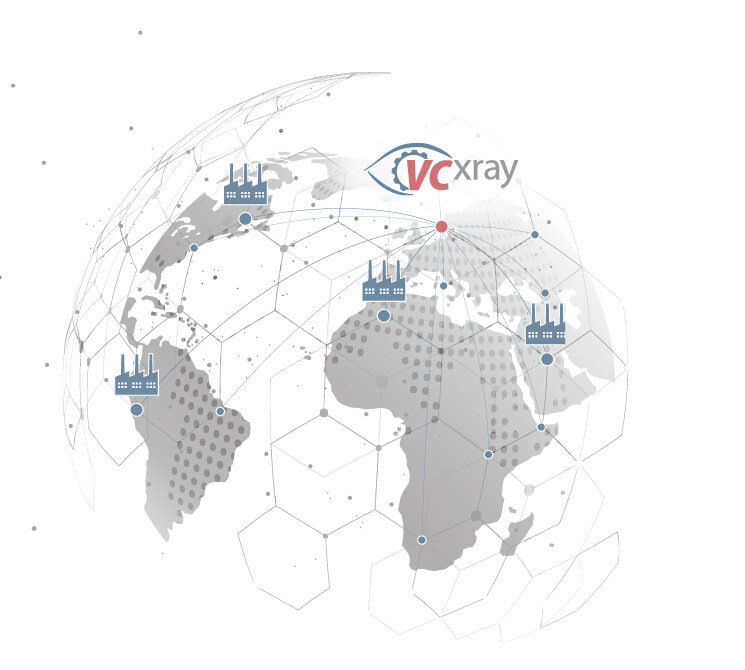
X-ray inspection systems for pipes, tubes, and tanks
Quality assurance and material testing of pipelines are critical to ensure that they meet the required standards and specifications and function safely and reliably. As pipelines are used in various industries such as oil and gas, chemical, water and wastewater, power, and other critical infrastructure, ensuring their integrity is paramount.
Quality assurance and material testing should be performed initially during manufacture and continuously throughout the pipeline's lifecycle, from design and manufacture to operation and maintenance, to ensure that it remains in optimal condition and serves its purpose safely and efficiently.
There are various methods for manufacturing pipelines, including seamless rolling, longitudinal seam welding (LSAW), spiral welding (SSAW), electric resistance welding (ERW), welded stainless steel pipe, extrusion, and cast iron pipe. Each process has its own advantages and disadvantages and is selected depending on the application and requirements. Selecting the right manufacturing process is critical to obtaining high quality and reliable piping. Accordingly, the requirements for material testing are also very diverse.
Corrosion is one of the most common and dangerous defects in pipelines in service. It can reduce the wall thickness of the pipes and lead to leaks or breaks.
Cracks can occur due to material fatigue, stresses or external loads. They affect the structural integrity of the pipeline and can lead to sudden failure.
Irregularities in the material, such as voids, blowholes or inclusions, can affect the strength and durability of the pipes.
The quality of welds is critical to the integrity of the piping. Weld defects such as voids, pores, or incomplete penetration can lead to weak spots.
Wear can occur in pipelines that carry abrasive or abrasive materials. It can lead to a reduction in wall thickness and increased risk of leakage.
Leaks may indicate cracks, damaged seals, or defective connections.
Deposits and blockages can affect flow and reduce pipeline performance.
Foreign matter or contaminants may block or corrode the pipeline.
Pipelines can weaken over time due to aging and environmental effects. Inspection must consider the effects of aging and material fatigue.
X-ray testing (also called X-ray inspection) is a non-destructive testing (NDT) method commonly used on pipelines to detect potential defects and anomalies inside the pipes. This method is based on the use of X-rays or gamma rays.
X-ray inspection can detect various defects in pipelines, including:
X-ray testing is a reliable method for inspecting piping because it is non-invasive and does not cause damage to the materials being inspected. It is especially important for safety-critical applications such as in the oil and gas, chemical, and other industries where pipeline integrity is critical.
International standards for X-ray inspection of piping include ISO 17636 for the inspection of welds, and EN 10246-7 for the non-destructive testing of steel pipes. These standards specify requirements and procedures to ensure reliable and safe X-ray inspection. The choice of the appropriate standard depends on the specific requirements and application.
API has developed standards for X-ray inspection of piping, including API 1104 for welding, API 5L for piping, API 5CT for casing and tubing, and API 570 for in-service inspections.
ASME has also developed standards for piping inspection. In particular, ASME Section V for general nondestructive testing is relevant to X-ray inspection. Furthermore, requirements for image format and archiving are specified. For example, the internationally recognized DICONDE format is often required.
These standards ensure compliance with industry guidelines and ensure reliable and safe pipelines in various applications. Due to the high demands placed on testing technology in this highly sensitive area, it is strongly recommended that an expert consultant be consulted.
VCxray offers a variety of solutions for pipeline testing.
For in-service testing, companies need portable systems that can be used to test for corrosion or wear in the field. Here, a high degree of portability, robustness, and speed is essential.
Testing at the end of the manufacturing process is of particular importance. Here, our customers can choose from an extensive portfolio of manual, semi-automatic, and fully automatic systems. Depending on how demanding the required cycle time is, the system is designed. Furthermore, there are specific solutions for clad pipes, spiral welded pipes, longitudinal welded pipes, and the screening of weld ends.
Choosing the right system can be complex, and a good decision must weigh many parameters such as size, speed, cost, etc. Contact our product specialists for further advice.
Contact us now!
Improve the quality and safety of your welds and piping with our state-of-the-art X-ray systems. Contact us today to learn more about our material inspection solutions for pipeline construction. Our team is always available to answer your questions and develop a customized solution for your needs.

With our Service centers and Hubs worldwide,
we will complete your staff with maximum
efficiency in your specified time frame and
without interrupting your operations.
No matter where you are, we are never far away.
Our knowledge and experience
maximize your company‘s profits.